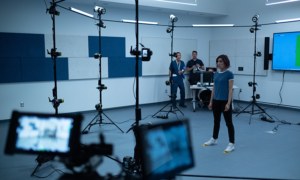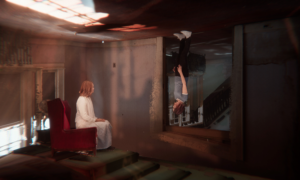Directed by genre icon Neill Blomkamp (in his first feature film since 2015’s Chappie), Demonic tells the story of Carly (Carly Pope, Elysium) a young woman who is approached by a mysterious company saying her estranged serial killer mother is in a coma and they have the technology to reach into her mind to find out answers as to her mother’s curious and violent past.
Hoping to dispel the demons of her youth, Carly takes the company up on their offer but in the process unleashes a terrifying demon. What are the secrets to her mother’s past? Can she defeat the demon before it hurts more people and just who is this mysterious company that seems to have links to the Vatican?
To try and uncover some of these secrets, we spoke to Blomkamp (pictured above) about making Demonic during the Covid-19 pandemic, directing a horror movie for the first time and a District 9 sequel…
When did you first get the idea for Demonic?
I would say, probably a month after the pandemic was clearly very serious and that any other larger Hollywood film was paused until everyone figured out what was going on.
It was like, ‘well, I want to shoot something’, and I’ve always in the back of my mind had this interest in the self-funded nature of Paranormal Activity and The Blair Witch Project and how effective those were at moving audiences. I knew I wanted to do something like that at some point, and then the timing just made sense. But I didn’t have a story and I didn’t really have an idea, so the film was a process of reverse engineering things that I had access to. But the goal was to be scary. The goal was to have this underlying brooding dread that ran through the movie, and so every choice that I made was trying to go after that.
What was the process of creating the movie during the pandemic?
It was definitely more complicated than normal! We were also doing it so early on that we were kind of figuring out what the rules were, and we were being told we were one of the first productions doing anything so the guilds had to tell us what the requirements were and we had to learn them as we were going. But it was fine.
The normal process would be, you sit down and write a screenplay, and you reverse engineer production to fit into that. So it’s like whenever you write, either we’re going to go to a real one, or we have to build one.
In this, because the budget is so low, it’s like ‘what do we have access to?’ So the building at the end [of the movie], the sanatorium, was a location that’s not that far from here. Then I knew that I wanted to work with Carly [Pope]. I liked her from all the old stuff that we did and I think she’s really talented, so it was like ‘let me construct something knowing that she’s the lead’.
[I also wanted] the VR simulation stuff in the film. We knew that we wanted to do something with volumetric capture running inside of a game engine, and try to put it into a narrative film somehow. So if you’re having an exorcism/demonic possession concept, [alongside] the idea of horror and low budget, maybe we can use the VR stuff. So then I brought that in. It’s like throwing these puzzle pieces in and then seeing what you can do with them!
Speaking of VR, when Carly goes into the mind of her mother, the world looks like a retro video game. How did you define the look of these sequences?
The look is defined by this ultra-unique technology that we were using that’s not that common yet called volumetric capture. It’s kind of glitchy, and it’s relatively low resolution, because it’s so new.
The actors in [those] scenes were surrounded by 260 cameras and there’s a large dome with maybe 160 cameras. They were super claustrophobic. Then there were these closer-up mobile smaller hemispheres that have 50 cameras per hemisphere that we would move close to the actors’ faces. So they were stuck in this highly regimented environment.
Then the photogrammetry software extrapolates them in 3D – you basically get a three-dimensional holographic video out of what you’re gathering. My brother and I have a small production company together and we knew that we wanted to use that at some point. So it is actually running on a game engine.
When we had the idea for a low-budget horror, I was like, ‘oh, well, what if we try that?’ Let’s take that out of the bin of ideas and see if we can use it. Then because it looks glitchy and it looks low resolution, the way to use it narratively would be that it would be in some kind of prototype VR simulation thing that maybe wasn’t in mass usage yet. Then if you combine that with demon possession and exorcism, you end up with something that’s an interesting overlap between science fiction and horror that I thought was cool. So I kind of reverse-engineered everything from that.

Was it always the plan to mix genres with Demonic?
I wouldn’t say it’s as conscious as that. It’s more a case of gravitating towards what I find creatively interesting. So I like the concept of the Vatican operating on this tech company kind of level and buying up companies that would be very cutting edge. I thought it was interesting, and using it as a way to flush out who is possessed and who isn’t.
Speaking of which… do you think the Vatican might have secret companies to flush out demons?!
Haha yeah my mum asked me if it was real, hilariously! But no, I mean the Vatican actually does have exorcism courses that priests can go on, so it’s real in that sense! Actually, now that you bring that up, there is this absolutely incredible group of soldiers that protect the Pope. It’s totally unrelated to this movie but their uniform is centuries old and they have yellow and purple stripes that make them up. They’re called the [Swiss] Guard. They’re super unique looking.
How did you decide on the look for the demon in Demonic?
I don’t know where the concept of wanting him to look like a raven or a crow comes from, but I knew that I wanted it to look that way, and that it had a beak, and that it was an anthropomorphic kind of two-legged bird.
I was a bit worried that the audience would think it was goofy, but I also felt like if it was done properly, it would be terrifying. So I was willing to risk that. I have this amazing concept artist who took the description and illustrated exactly what I had in my head, which was really satisfying. Then, what was highly unusual in this particular filmmaking process was, we built a physical suit of the creature with a suit performer who’s very tall (when you combine all of the heights of the added crow head and everything to him I think it was way over seven feet!) and we took that physical creature and dropped it into the 260 camera volume capture environment.
That is a highly backwards way of doing it – the way that you would normally do it is to end up with computer graphics. Everything would be built into the computer. You would never take a three-dimensional object, especially if it’s non-human, and capture them for real, and then drop them into CG. So it was a really strange process but that motion that you see is pretty much all from our suit performer and me specifying this kind of jerky bird-like movement. The way that birds move is very un-fluid. It’s binary how they look when they move, so he was trying to do that, and the result if you underline it and you treat it correctly, is this ominous feeling.
What’s really interesting is, because it runs on the game engine, you can witness those scenes in pure virtual reality. It’s not some film gimmick, it’s actually full three-dimensional VR running on a high-end game engine. So you can stand in the hallway with that creature in full 3D and move around. You can walk around the volume of this room with that. It’s pretty cool.
What was it like switching to directing a horror movie for Demonic?
To be honest, I didn’t follow any kind of rulebook. I don’t actually know what the requirements are for horror. I knew that it wasn’t gore horror, it’s not torture porn horror, it’s a little bit closer to psychological supernatural horror. Then I also know that there are sci-fi elements. So how do I incorporate those? I wasn’t really trying to follow a rulebook per se I was just putting the story elements together in a way that I felt was most cohesive.
What I would say is that the goal was simple. The goal was that I just wanted it to create a sense of dread in the audience. Everything that I did was designed to try to reinforce that. So, even if they’re walking around in a sunny environment outdoors, I wanted it to feel ominous. So it’s less about continuous jump-scares and more about the sustained uncomfortableness that runs underneath the movie the whole time.

What do you think it is about horror that appeals to audiences? Why do we love to be scared?
I honestly do not know. I think about it a lot. It’s very strange, the idea that you would pay money and voluntarily sit for two hours to feel uncomfortable. [It] is such a strange psychological thing. But there’s obviously some sort of catharsis, or there’s something that is happening psychologically that is beneficial to the audience. So I don’t know, but I think about it all the time.
What do you want audiences to take away from Demonic?
I want them to be scared, on a sustained brooding level. That’s what my goal was, if I don’t feel anything, I failed. So, it’s meant to bother them.
What’s next for you?
I have a sci-fi film that I’m writing right now, that I love. I hope that I make that. I don’t know how it’s going to net out though with the budget and everything else but it’s very high on my list.
I’m also working on the script for our sequel to District 9 as well…
Signature Entertainment’s Demonic opens FrightFest 26 August and is at UK Cinemas, Premium Digital 27 August and Blu-ray and DVD 25 October.
